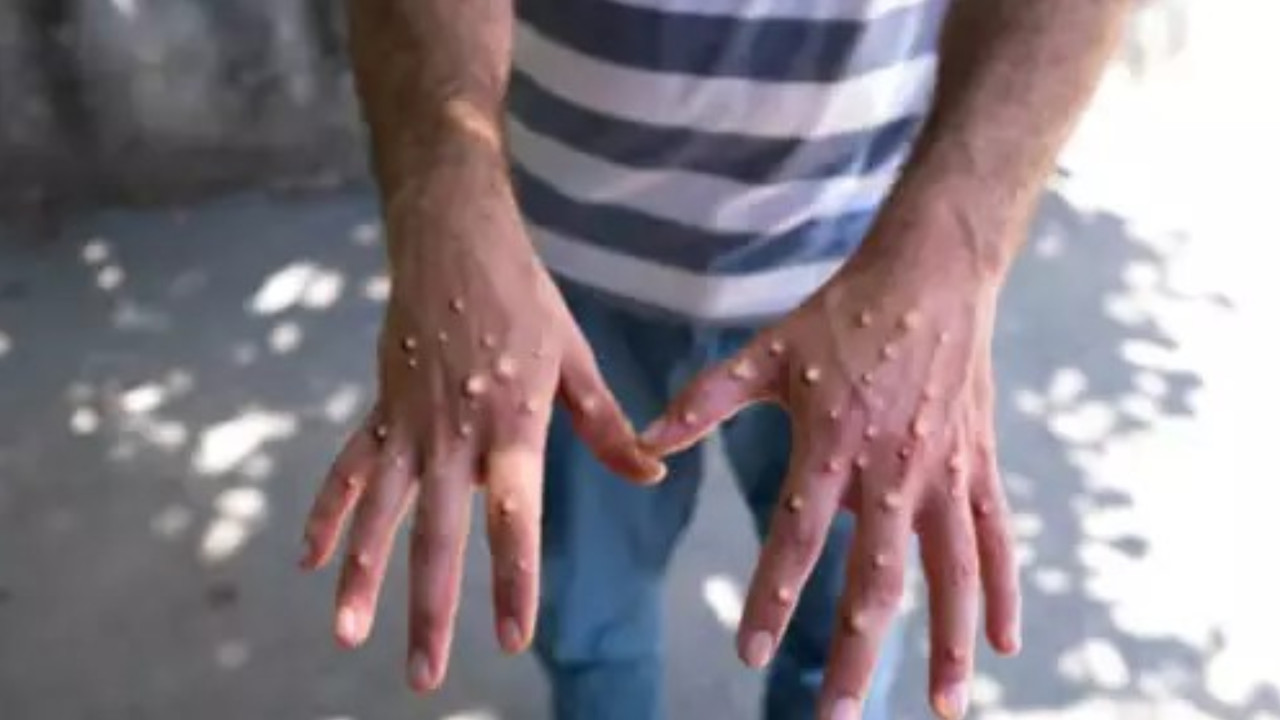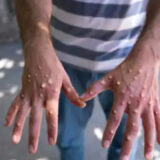Understanding the Monkeypox Virus: Symptoms, Transmission, and Prevention
Monkeypox is a viral disease caused by the monkeypox virus, which belongs to the same family of viruses as smallpox but is generally less severe. It was first identified in 1958 when outbreaks occurred in laboratory monkeys, but it was not until 1970 that it was identified in humans in the Democratic Republic of the Congo.
The symptoms of monkeypox are similar to smallpox, but milder. They include fever, headache, muscle aches, backaches, swollen lymph nodes, chills, and exhaustion. A distinctive rash often develops, starting as flat lesions that turn into raised bumps and eventually form pustules and scabs.
Monkeypox is primarily transmitted to humans through contact with infected animals, such as rodents or primates, or through human-to-human transmission via respiratory droplets, bodily fluids, or contaminated materials like bedding or clothing.
What is Monkeypox?
Monkeypox is a rare viral zoonotic disease caused by the monkeypox virus, which belongs to the same family of viruses as smallpox, known as the Poxviridae family. The disease was first identified in laboratory monkeys in 1958, hence its name, but it is primarily found in rodents and other wild animals.
Symptoms of Monkeypox:
- Initial Symptoms: Fever, headache, muscle aches, backache, swollen lymph nodes, chills, and exhaustion.
- Skin Lesions: A characteristic rash that begins with flat spots, progresses to raised bumps, then to fluid-filled blisters, and finally crusts over. The rash often starts on the face and spreads to other parts of the body.
- Duration: The illness typically lasts 2-4 weeks.
Transmission:
Monkeypox can be transmitted to humans through:
- Direct Contact: With infected animals (e.g., rodents or primates).
- Human-to-Human: Through respiratory droplets, bodily fluids, or direct contact with lesions or contaminated materials.
- Contaminated Objects: Such as bedding or clothing from an infected person.
The History of the Monkeypox Virus
Discovery and Early Observations:
- 1958: The monkeypox virus was first identified in laboratory monkeys in Denmark. This discovery gave the disease its name, but the disease was noted in other animals before being recognized in humans.
- 1970: The first human case of monkeypox was reported in the Democratic Republic of Congo (DRC). This marked the start of the disease’s recognition in human populations.
Early Outbreaks:
- 1970s-1980s: Sporadic cases of monkeypox were reported in Central and West Africa. These outbreaks were typically confined to rural and remote areas and often linked to contact with infected animals.
Recent Developments:
- 2003: The first outbreak of monkeypox outside Africa occurred in the United States. The outbreak was linked to pet prairie dogs that had been in contact with imported animals from Africa.
- 2017: The Democratic Republic of Congo experienced one of the largest outbreaks of monkeypox in recent years, with increased cases reported.
- 2018-2019: Monkeypox outbreaks were reported in several African countries, including Nigeria, where there were significant efforts to control and monitor the disease.
- 2022: An unusual global outbreak of monkeypox occurred, with cases reported in many countries outside of Africa. This marked a significant shift in the disease’s geographic distribution and prompted increased global health responses.
Types of Monkeypox Virus
Monkeypox virus is classified into different clades (or lineages) based on its genetic variations. The two main clades of the monkeypox virus are:
1. Clade I (Central African)
- Geographic Distribution: This clade is primarily found in Central Africa, including countries such as the Democratic Republic of Congo (DRC) and the Central African Republic.
Characteristics:
- Severity: Clade I is generally associated with more severe illness compared to Clade II.
- Symptoms: It often presents with a higher fatality rate and more extensive rashes.
- Transmission: It has a higher transmission rate and can lead to more significant outbreaks.
2. Clade II (West African)
- Geographic Distribution: This clade is found in West Africa, including countries like Nigeria, Ghana, and Sierra Leone.
Characteristics:
- Severity: Clade II is usually associated with a milder form of the disease compared to Clade I.
- Symptoms: It tends to result in less severe illness with a lower fatality rate.
- Transmission: Although still a serious disease, outbreaks caused by Clade II generally have fewer complications and lower mortality rates.
Distinguishing Features
- Genetic Differences: The two clades differ in their genetic makeup, which influences their virulence, disease progression, and epidemiological patterns.
- Outbreak Patterns: Clade I is more common in Central Africa and is associated with larger and more severe outbreaks, while Clade II has been identified in West Africa and tends to be less severe but still significant.
Understanding these clades helps in tracking the spread of monkeypox, developing targeted public health responses, and improving diagnostic and treatment strategies.
How Monkeypox Virus Spreads?
Monkeypox virus can spread through several routes, primarily from animals to humans and between humans. Understanding these transmission pathways is crucial for controlling and preventing outbreaks.
Animal to Human Transmission
1. Direct Contact with Infected Animals:
- Primary Hosts: The virus is primarily found in wild animals such as rodents and primates, which can harbor the virus without showing symptoms.
- Transmission: Humans can contract monkeypox through direct contact with the blood, bodily fluids, or lesions of infected animals. This can occur through handling or consuming the meat of infected animals.
2. Infected Animal Products:
- Contaminated Materials: Handling or consuming products derived from infected animals, such as meat or fur, can also pose a risk. The virus can survive on surfaces and materials, leading to potential infection if these are not properly managed.
Human to Human Transmission
1. Respiratory Droplets:
- Close Contact: The virus can spread through respiratory droplets from an infected person, especially in close and prolonged contact settings. This is less common but possible, particularly in crowded or confined environments.
2. Direct Contact with Lesions or Bodily Fluids:
- Skin Lesions: Contact with the lesions or sores of an infected person can transmit the virus. This includes touching, scratching, or coming into contact with contaminated bedding or clothing.
- Bodily Fluids: The virus can also spread through contact with bodily fluids, including saliva, blood, and other secretions from an infected person.
3. Contaminated Objects:
- Fomites: Objects such as bedding, clothing, or utensils that have been contaminated by an infected person’s lesions or bodily fluids can act as vectors for the virus. Handling these items without proper hygiene can lead to transmission.
4. Healthcare Settings:
- Nosocomial Transmission: In healthcare settings, the virus can spread if proper infection control measures are not in place. This includes the use of personal protective equipment (PPE) and strict hygiene protocols.
Preventive Measures
- Avoid Contact with Infected Animals: Refrain from handling or consuming meat from wild animals that could be infected.
- Practice Good Hygiene: Wash hands frequently, use protective equipment when dealing with potentially infected individuals or materials, and maintain good sanitation practices.
- Isolate Infected Individuals: Infected persons should be isolated to prevent the spread of the virus, and healthcare providers should use appropriate PPE.
- Educate and Monitor: Awareness campaigns and monitoring of potential outbreaks help in early detection and control measures.
Understanding these transmission pathways helps in implementing effective prevention strategies and managing outbreaks more efficiently.
Symptoms of Monkeypox Virus
Monkeypox presents with a range of symptoms that can vary in severity. The disease typically progresses through distinct stages, beginning with early symptoms, followed by rash development, and potentially leading to complications.
Early Symptoms
- Fever: Often one of the first signs, fever typically appears within a few days of infection.
- Headache: Severe headaches may accompany the fever.
- Muscle Aches: Generalized muscle pain or backaches are common.
- Fatigue: Individuals may experience significant tiredness and weakness.
- Swollen Lymph Nodes: Lymphadenopathy (swelling of the lymph nodes) is a hallmark of monkeypox and can be observed in the neck, armpits, and groin.
- Chills and Exhaustion: Patients often feel chilled and may experience overall exhaustion.
Rash Development
1. Onset of Rash:
- Initial Stage: The rash usually begins with flat, red spots on the face or other areas of the body. These spots are initially small and can be mistaken for other types of rashes.
Progression of Rash:
- Papules: The flat spots evolve into raised bumps or papules. These bumps are often firm and may feel itchy.
- Vesicles: The papules develop into fluid-filled blisters known as vesicles. These blisters are often painful and can become pustular (filled with pus).
- Crusting: The vesicles eventually crust over, forming scabs. These scabs fall off as the skin heals, leaving areas of pigmentation.
Rash Distribution:
- Location: The rash typically starts on the face and then spreads to other parts of the body, including the arms, legs, and trunk. In some cases, it may also involve mucous membranes, such as the mouth and genitals.
Complications
1. Secondary Bacterial Infections:
- Risk: The open sores and blisters can become infected with bacteria, leading to secondary infections that may require antibiotic treatment.
2. Pneumonia:
Respiratory Complications: Severe cases can develop pneumonia, which can complicate the respiratory system and require hospitalization.
3. Encephalitis:
- Neurological Issues: In rare cases, monkeypox can lead to inflammation of the brain (encephalitis), causing symptoms such as confusion, seizures, or altered mental status.
4. Ocular Issues:
- Eye Involvement: The infection can affect the eyes, potentially leading to conjunctivitis or corneal scarring, which may impact vision.
5. Dehydration:
- Fluid Loss: Severe cases with extensive rash and fever can lead to dehydration, requiring intravenous fluids and supportive care.
6. Long-Term Effects:
- Scarring: The skin lesions and rash can leave permanent scars or pigmentation changes, especially if the rash is severe.
Management and Treatment
- Supportive Care: Most cases are managed with supportive care, including hydration, pain relief, and treatment of secondary infections.
- Antiviral Treatment: In severe cases, antiviral medications such as Tecovirimat (TPOXX) may be used, particularly in cases with significant complications.
- Monitoring: Continuous monitoring for complications is crucial, especially in high-risk groups or severe cases.
Understanding the progression of symptoms and potential complications can help in early diagnosis and effective management of monkeypox.
Diagnosis of Monkeypox Virus
Diagnosing monkeypox involves a combination of clinical evaluation, laboratory tests, and patient history. Accurate diagnosis is essential for appropriate management and preventing the spread of the virus. Here’s an overview of the diagnostic process for monkeypox:
1. Clinical Evaluation
- Medical History: The healthcare provider will take a detailed medical history, including recent travel to areas where monkeypox is endemic, exposure to potentially infected animals, or contact with individuals who have symptoms consistent with monkeypox.
- Symptom Assessment: A thorough examination is conducted to identify key symptoms, such as fever, swollen lymph nodes, and the characteristic rash with distinct stages (from flat spots to pustules).
2. Laboratory Testing
Polymerase Chain Reaction (PCR) Testing:
- Procedure: PCR is the most sensitive and specific method for diagnosing monkeypox. It detects the virus’s DNA in samples taken from skin lesions, blood, or other bodily fluids.
- Advantages: PCR testing is highly accurate and can differentiate monkeypox from other similar viruses, such as smallpox or varicella (chickenpox).
Viral Culture:
- Procedure: This involves isolating the virus from samples collected from skin lesions or other bodily fluids. Although less commonly used, viral culture helps confirm the presence of the virus and can be used to study the virus strain.
- Advantages: Provides additional confirmation of the virus and allows for further research on the strain.
Serology:
- Procedure: Serological tests detect antibodies produced in response to the monkeypox virus. These tests are useful for confirming past infections or in cases where PCR is not available.
- Limitations: Serological tests are less commonly used for early diagnosis since antibodies may not be present in the early stages of infection.
Electron Microscopy:
- Procedure: Electron microscopy can be used to visualize the virus particles in tissue samples or lesion fluids. It provides direct evidence of the virus but is less commonly used due to the availability of more specific tests.
- Advantages: Useful in confirming the presence of poxvirus particles.
3. Differential Diagnosis
To ensure accurate diagnosis, healthcare providers will differentiate monkeypox from other diseases with similar symptoms, such as:
- Smallpox: Both diseases cause similar skin lesions, but smallpox is eradicated, making it less likely to be encountered.
- Chickenpox (Varicella): Chickenpox presents with a different rash pattern and fewer systemic symptoms.
- Syphilis: Secondary syphilis can cause skin lesions that may resemble monkeypox lesions.
- Herpes Simplex Virus (HSV): HSV can cause sores that may be confused with monkeypox lesions.
4. Sample Collection
- Skin Lesions: Lesion samples are collected using swabs or biopsy for PCR testing and culture.
- Blood: Blood samples may be taken to test for viral DNA or antibodies.
- Other Bodily Fluids: In some cases, other fluids such as saliva or cerebrospinal fluid (if neurological symptoms are present) may be tested.
Treatment and Management of Monkeypox
Monkeypox management focuses on symptomatic relief and, in severe cases, antiviral treatment. There is no specific antiviral drug approved exclusively for monkeypox, but general supportive care and certain antiviral medications can help manage the disease effectively.
1. Symptomatic Treatment
Symptomatic treatment aims to alleviate symptoms and improve patient comfort. Key aspects include:
Fever Management:
- Medications: Antipyretics such as acetaminophen (Tylenol) or ibuprofen (Advil) can help reduce fever and relieve associated discomfort.
- Hydration: Ensure adequate fluid intake to prevent dehydration caused by fever and sweating.
Pain and Itch Relief:
- Topical Treatments: Creams or ointments containing antihistamines or calamine lotion may be used to alleviate itching and skin discomfort.
- Oral Pain Relievers: Nonsteroidal anti-inflammatory drugs (NSAIDs) can help manage pain and inflammation.
Skin Care:
- Wound Care: Keep skin lesions clean and dry to prevent secondary bacterial infections. Use mild antiseptic solutions if necessary.
- Avoid Scratching: Encourage patients to avoid scratching or picking at lesions to reduce the risk of infection and scarring.
Hydration and Nutrition:
- Diet: Provide a balanced diet rich in nutrients to support the immune system and recovery. If oral intake is challenging, intravenous fluids may be administered.
- Monitor for Dehydration: Particularly important if the patient experiences significant fluid loss due to fever or vomiting.
While no antiviral drug is specifically approved for monkeypox, certain antiviral medications used for related viral infections may be effective:
Tecovirimat (TPOXX):
- Description: Tecovirimat is an antiviral drug that is effective against smallpox and has shown promise in treating monkeypox. It works by inhibiting the replication of the virus.
- Usage: Typically used in severe cases or for high-risk patients. It is available under an expanded access provision or investigational new drug protocols.
Cidofovir:
- Description: Cidofovir is an antiviral drug used for other viral infections such as cytomegalovirus (CMV). It has been used off-label for monkeypox.
- Usage: Given intravenously, it is considered for severe cases or when other treatments are not available.
Vaccinia Immune Globulin (VIG):
- Description: This treatment contains antibodies derived from individuals vaccinated against smallpox. It may be used to provide passive immunity.
- Usage: Primarily used for severe cases or when other treatments are unavailable.
3. Additional Measures
- Isolation: Patients with monkeypox should be isolated to prevent the spread of the virus to others. Strict infection control measures should be followed.
- Infection Control: Healthcare workers should use personal protective equipment (PPE) and follow hygiene protocols to prevent nosocomial transmission.
- Monitoring: Regular monitoring of patients for complications and response to treatment is crucial, especially in severe cases.
Prevention of Monkeypox Virus
Preventing monkeypox involves a combination of vaccination, good hygiene practices, and travel precautions. Each of these measures plays a critical role in reducing the risk of infection and controlling outbreaks.
1. Vaccination
Smallpox Vaccine: The smallpox vaccine (vaccinia virus) has been shown to provide cross-protection against monkeypox due to the genetic similarities between the two viruses. Although routine smallpox vaccination was discontinued after smallpox was eradicated, it remains a preventive measure for high-risk individuals and in outbreak situations.
- Eligibility: Individuals at high risk of exposure, such as healthcare workers or those in contact with infected individuals, may be advised to receive the vaccine.
- Availability: The vaccine is available in some countries under specific circumstances, including emergency situations and high-risk settings.
Monkeypox-Specific Vaccines: Research is ongoing to develop vaccines specifically for monkeypox. These vaccines aim to provide targeted protection against the monkeypox virus.
2. Hygiene Practices
Hand Hygiene: Regular handwashing with soap and water is essential, particularly after contact with potentially contaminated surfaces, animals, or individuals.
- Hand Sanitizer: Use alcohol-based hand sanitizers when soap and water are not available.
Avoiding Contact with Infected Individuals:
- Isolation: Ensure that individuals with monkeypox are isolated from others to prevent the spread of the virus.
- PPE Use: Healthcare workers and caregivers should use personal protective equipment (PPE) such as gloves, masks, and gowns when in contact with infected patients.
Sanitation and Disinfection:
- Cleaning: Regularly clean and disinfect surfaces, especially those that may have come into contact with bodily fluids or skin lesions.
- Laundry: Wash contaminated clothing, bedding, and linens with hot water and detergent to kill the virus.
Avoiding Contact with Animals:
- Wildlife: Refrain from handling or consuming meat from wild animals that may be infected with monkeypox.
- Pets: Although monkeypox is primarily a zoonotic disease, avoid close contact with animals that may have been exposed to the virus.
3. Travel Precautions
Avoiding Endemic Areas:
- Travel Advisory: Avoid travel to regions where monkeypox is known to be prevalent if not necessary. Stay informed about outbreaks and follow travel advisories from health authorities.
Health Precautions:
- Pre-Travel: Check for any recommended vaccinations or health precautions before traveling to areas where monkeypox is present.
- During Travel: Practice good hygiene, avoid contact with animals, and be cautious in crowded or high-risk environments.
Monitoring Health:
- Post-Travel: Monitor for any symptoms of monkeypox, such as fever, rash, or swollen lymph nodes, after traveling to an area with known outbreaks. Seek medical advice if symptoms develop.
Reporting Symptoms:
- Health Alerts: Report any symptoms consistent with monkeypox to a healthcare provider, especially if there has been recent travel to an endemic area.
Monkeypox Virus vs. Smallpox
Monkeypox and smallpox are both viral infections caused by orthopoxviruses, but they differ significantly in their transmission, symptoms, and impact. Here’s a comparative overview of the two viruses:
1. Causative Agents
Monkeypox:
- Virus: Caused by the monkeypox virus, which is part of the Orthopoxvirus genus in the Poxviridae family.
- Species: There are two main clades: Central African (Clade I) and West African (Clade II).
Smallpox:
- Virus: Caused by the variola virus, also part of the Orthopoxvirus genus.
- Types: Two main types: Variola major (more severe) and Variola minor (less severe).
2. Transmission
Monkeypox:
- Animal to Human: Transmission occurs through contact with infected animals, such as rodents or primates.
- Human to Human: Can spread through close contact with infected individuals, including bodily fluids, respiratory droplets, and contaminated materials. It is less contagious than smallpox.
- Transmission Mechanisms: Direct contact with skin lesions, respiratory droplets, and contaminated surfaces.
Smallpox:
- Human to Human: Primarily spread through respiratory droplets from coughs or sneezes. It can also be transmitted through direct contact with contaminated materials or skin lesions.
- High Contagiousness: Smallpox is highly contagious and spreads efficiently in crowded or close-contact settings.
3. Symptoms
Monkeypox:
- Early Symptoms: Fever, headache, muscle aches, backache, swollen lymph nodes, and exhaustion.
- Rash Development: Rash progresses from flat spots to papules, vesicles, pustules, and then scabs, typically starting on the face and spreading to other parts of the body.
Severity: Generally less severe than smallpox, with a lower mortality rate.
Smallpox:
- Early Symptoms: High fever, severe headache, backache, and malaise, followed by a characteristic rash.
- Rash Development: Rash starts in the mouth and on the face, then spreads to the arms, legs, and trunk. The rash progresses through similar stages as monkeypox but often with a more severe presentation.
Severity: Smallpox was a highly severe disease with a high mortality rate, especially Variola major.
4. Complications
Monkeypox:
- Complications: Can include secondary bacterial infections, pneumonia, encephalitis, and ocular complications. Long-term effects may include scarring.
- Mortality Rate: Lower than smallpox, with a fatality rate ranging from 1% to 10%, depending on the clade and patient factors.
Smallpox:
- Complications: Included severe complications such as blindness, pneumonia, and septicemia. Variola major had a mortality rate of about 30%.
- Mortality Rate: High mortality rate, with significant morbidity and mortality associated with the disease.
5. Vaccination and Eradication
Monkeypox:
- Vaccination: The smallpox vaccine offers some cross-protection against monkeypox but is not specifically approved for it. Research is ongoing for monkeypox-specific vaccines.
- Current Status: Monkeypox is endemic in certain parts of Africa but is not eradicated globally.
Smallpox:
- Vaccination: The smallpox vaccine was highly effective and was a critical tool in the global eradication campaign.
- Eradication: Smallpox was declared eradicated by the World Health Organization (WHO) in 1980 following an extensive vaccination campaign. Routine vaccination is no longer conducted.
6. Public Health Response
Monkeypox:
- Management: Focuses on symptomatic treatment, supportive care, and isolation of infected individuals. Outbreaks are managed with contact tracing and infection control measures.
- Monitoring: Surveillance for outbreaks and research into vaccines and treatments continue.
Smallpox:
- Management: Historically, involved vaccination campaigns, quarantine, and isolation. With its eradication, the focus has shifted to maintaining the vaccine stockpile and preparedness for potential re-emergence scenarios.
Global Spread and Current Situation of Monkeypox
Regions Affected
Monkeypox has historically been endemic to certain African countries, primarily in the central and western regions. However, the 2022 outbreak saw a significant global spread, affecting numerous countries across different continents, including:
- Africa: The continent continues to be the epicenter of monkeypox, with several countries experiencing ongoing outbreaks and new cases. The Democratic Republic of Congo (DRC) has been particularly affected.
- Americas: Countries in North and South America reported cases during the 2022 outbreak, though the situation has largely stabilized.
- Europe: Many European countries experienced significant outbreaks in 2022, but the number of cases has decreased since then.
- Asia: Several Asian countries reported sporadic cases, but the impact has been relatively limited compared to other regions.
- Oceania: Australia and New Zealand reported a small number of cases during the 2022 outbreak.
Recent Outbreaks
While the global outbreak of 2022 has subsided in many regions, the situation in Africa remains concerning. The emergence of a new, more transmissible clade of the virus in the Democratic Republic of Congo has led to a resurgence of cases and prompted the World Health Organization (WHO) to declare a Public Health Emergency of International Concern (PHEIC).
The recent outbreak started in January 2023 in the Democratic Republic of Congo and has since reached 12 other countries in the region.
Sweden confirmed the first known infection of clade I outside Africa, though Swedish health officials said the person was infected while spending time in Africa. Health authorities in Pakistan also confirmed a case of mpox on Friday but have not identified the strain yet.
It’s important to note that the monkeypox situation is dynamic, and new outbreaks or changes in the epidemiological landscape can occur. Therefore, it’s essential to stay updated with the latest information from reliable sources such as the WHO and local health authorities.























